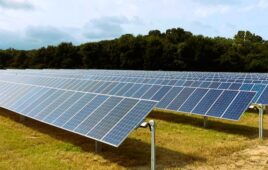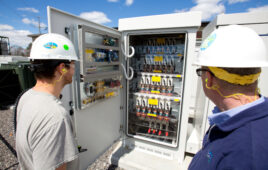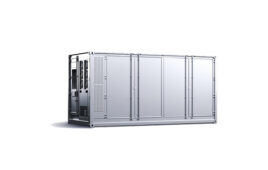Energy storage currently represents a tiny portion of the electricity and power industry—21 GW of capacity and about 2% of the nation’s peak demand, according to the Energy Storage Association (ESA). But that number is growing with more renewable energy. IMS Research notes that the global solar+storage market was less than $200 million in 2012, but will jump to $19 billion by 2017. That growth will involve a number of battery storage technologies.
![]()
According to GTM Research and ESA’s U.S Energy Storage Monitor 2016 Year in Review, lithium-ion represented at least 97% of all energy storage capacity deployed in 2016.
However, while lithium-ion batteries are expected to dominate stationary energy storage, flow batteries may have opportunities in large utility and long-duration applications.
Flow batteries store energy in an electrolyte solution. Their exchange of negatively and positively charged fluids produces electrical current with little degradation, providing a longer cycle life and quick response times. They can be scaled by increasing the amount of fluid in their tanks. However, their fluids can be corrosive or toxic.
Flow batteries are becoming cheaper, safer and more efficient. Vanadium chemistries currently lead the market, but others, such as Lockheed Martin’s metal complex scheduled to be out in 2018, could make flow batteries competitive in four-hour duration applications.
Primus Power has also released its second-generation flow battery with a five-hour duration and a 20-year expected life. Primus said its EnergyPod 2 has a total cost of ownership that’s up to 50% less than conventional lithium-ion battery systems. Microsoft is testing Primus storage systems for peak shaving.
Scientists with the Joint Center for Energy Storage Research, a research consortium lead by Argonne National Laboratory (lead by the DOE), have also developed an aqueous oxygen sulfur flow battery cell that could store energy for a month or more. This would be handy for seasonal storage in communities with long rainy seasons.
Other battery types also continue to advance. Gridtential received $6 million from investors including Crown Battery Manufacturing to advance lead-acid technology. It’s replacing the metal grid in current lead-acid battery designs with a silicon substrate for higher energy density, longer cycle life and deeper depth-of-discharge.





Besides “flow batteries”: there are iron-chromium flux capacitors, and pumped hydroelectric storage. There are also hydrogen fuel cell’s that can take the surplus electricity generated through the day to separate hydrogen from oxygen. Then during peak demand, the hydrogen is put through the hydrogen fuel cell, taking oxygen from the air, and generating electricity and pure water. And then, restarting the process all over again. Water and electricity via fuel cell sounds like a clean, efficient means of producing electricity without fossil fuel. Biomass to make methane and alcohol as well as dispose of human and animal waste is yet another innovation to provide for the electricity needs without “starving and freezing in the dark” with renewable energy. We have the technology and the natural resources to do this now. All we lack is the political will, because our elected leaders are beholden and owned by the profit addicted fossil fuel industry by their campaign finance contributions. Base demand and peaking demand can be met without fossil fuel or nuclear power by growing canola for extracting canola oil for bio-diesel. Add to the mix geothermal, tidal, ocean current and wind. You then have a varied source of fuels and methods to stabilize the electric grid loads and cope with peak demand.
Not sure why ViZn was omitted. The are building the largest flow batteries in India, Canada, Germany and Central America and they avoid the toxic chemistry challenges with a benign water based approach.